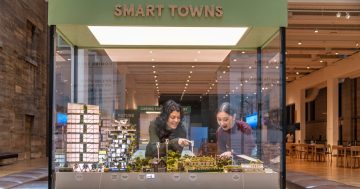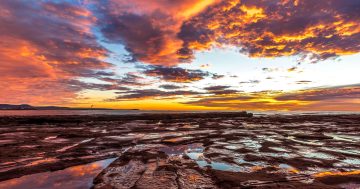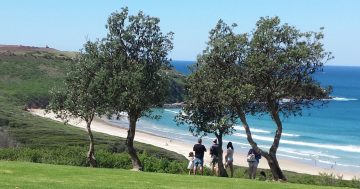
Edward Killalea (third from right) in an 1869 photo of Shellharbour Municipal Council. Photo: Destination Shellharbour.
Killalea is well known for its natural beauty and amazing surf breaks, but back in 1868 it also became known for gold found on its beautiful beach.
It was named for Edward Killalea, who rose from a convict transported to Australia for manslaughter, to pioneer and Shellharbour alderman.
According to Discover Shellharbour, Edward was born in Ireland in 1816. When he was 19 he was involved in a brawl in which two men were killed, and in 1836 he was charged with manslaughter and sentenced to Australia for the term of his natural life.
He arrived in NSW aboard the Captain Cook 3 on 13 November 1836.
Edward was issued a ticket of leave in January 1845, and a conditional pardon in 1850.
In 1847, Edward married, and he and his wife Maria worked on a clearing lease in the area now known as Killalea State Park, or The Farm. The family, which eventually included 12 children, lived in a slab hut down near the beach.
Edward became an important pioneer of Shellharbour and an enterprising settler. He was an alderman on Shellharbour Municipal Council from 1870-1872 and was on the committee to form the Shellharbour Steam Navigation Company.
In 1868, Edward became involved in a gold prospecting venture at Killalea Beach with Thomas Henry, a machine maker who had returned from gold mining in New Zealand, after discovering alluvial gold in the beach sand.
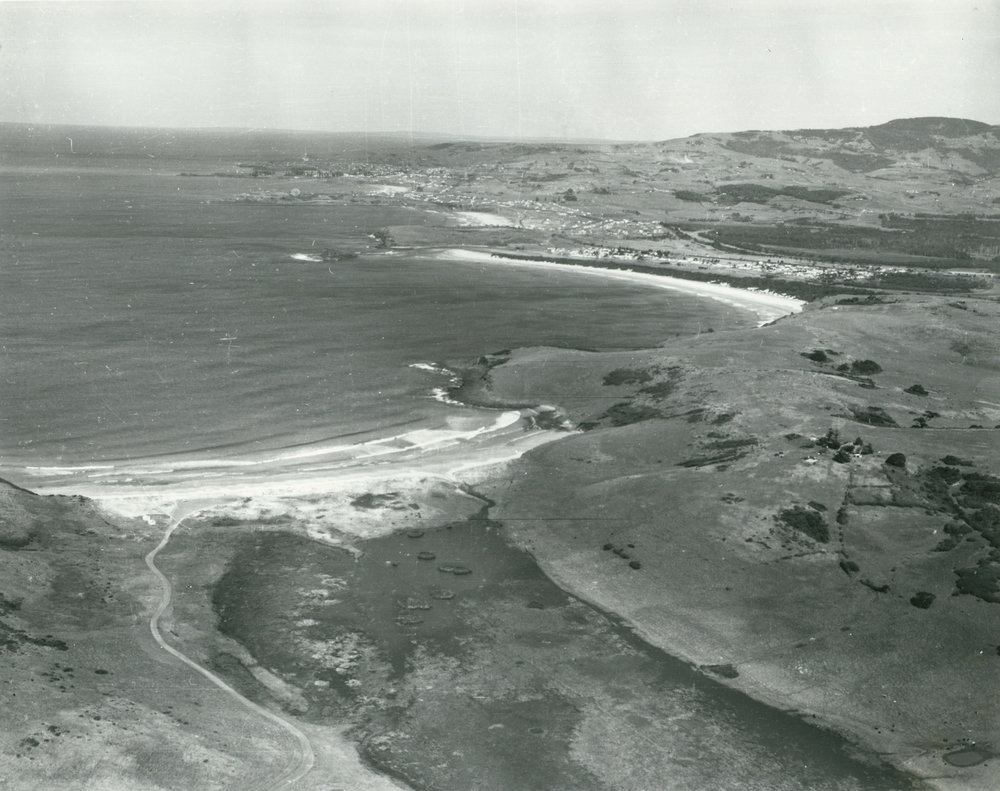
Killalea Beach in the 1970s, with Kiama in the background. Photo: Destination Shellharbour.
It appears that rumours were rife about the gold find, with the Illawarra Mercury reporting on 1 September 1868 that “we took satisfactory means during the past week of ascertaining the facts connected with those operations, as by the vague rumours and reports that have hitherto been circulated concerning them, it was impossible to arrive at any conclusion as to the real or possible truth of the matter”.
“It appears that on Mr Thomas Henry’s return from New Zealand, where he had acquired considerable experience in obtaining gold from sand on the seashore in that country, he determined on testing the sand on the beaches along the coast of these districts, for the purpose of ascertaining whether or not gold might be contained in it,” the Mercury article stated.
“The result of Mr Henry’s experiments in this sand prospecting was that after finding minute specks of gold in various places on several of the beaches, he decided, about a month ago, upon commencing operations on a practical scale at Mr Killalea’s, on a small sandy beach to the south of the “Long Point,” and about a mile in a straight direction from the shipping port of Shellharbour.”
The article went into great detail about the operation and how the sand was washed through a perforated hopper and separated from pebbles and stones before any “minute particles of gold” were captured on plates covered with quicksilver (mercury).
“As the party have not yet retorted any of the amalgam, they can only judge its value from appearance, which seems to inspire them with considerable hopes of success,” the Mercury article said.
“They express a confidence, however, of making “good wages” at the work, and the time and expense which they are spending on the prospect certainly go far to prove the sincerity of their statements.
“The machinery, exclusive of quicksilver and other items of expense, must have cost them a considerable amount of money. There is another party in active operations also at the same place, and seem equally pleased and hopeful with the prospectors.”
Unfortunately for Edward, the enterprise eventually failed and Thomas Henry left for the goldfields at Nerriga.
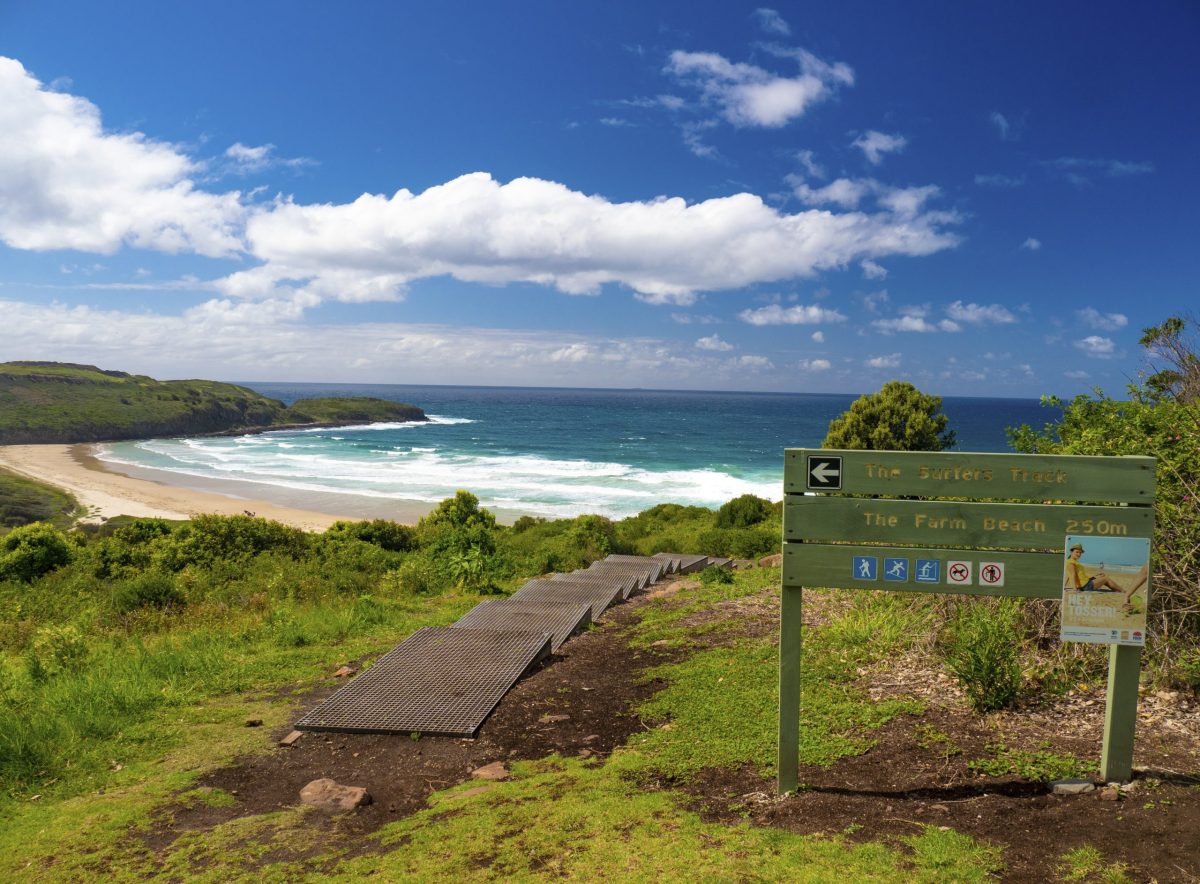
The Farm in Killalea State Park, Shellharbour. Photo: Mark Fitzpatrick/Destination NSW.
Edward died suddenly at the Commercial Hotel in Wollongong in 1872 after enduring several seizures.
An article in the Kiama Independent described him as: “The late Mr. Killalea, an old resident of Shellharbour, an alderman of the borough, the father of a large family of seven sons and five daughters, very generally, indeed we may say universally, respected for the kindliness of his disposition and integrity of character”.
The coroner and jury found “the deceased, Edward Killalea, came to his death by strychnine, taken by him whilst labouring under the effects of excessive drinking”. A bottle marked poison was found in his pocket. He was buried at the Shellharbour foreshore cemetery.
Maria had left Edward several months prior to his death and wasted little time in selling the property.
It was advertised in the Kiama Independent: “Highly important sale unreserved, Shellharbour. Goodwill of lease, choice dairy herd, working bullocks, young cattle etc. … DL Dymock has received instructions from Mrs Killalea to sell by auction, at her residence Long Point Shellharbour. Good will of lease on that truly magnificent farm on which she resides for a term of years, at a moderate rental, capable of grazing 300 head. After which the whole of her dairy stock, young cattle, working bullocks and horses, numbering 100 head more or less; pigs, household furniture, dairy utensils, drays, carts and farming implements. Also gold washing apparatus, used at the beach”.
Maria lived to a grand age of 86 years and is buried at Rookwood Cemetery in Sydney.
A plaque was placed on the site of the slab home in 1997 by the Killalea descendants, who gathered for a reunion and unveiling.
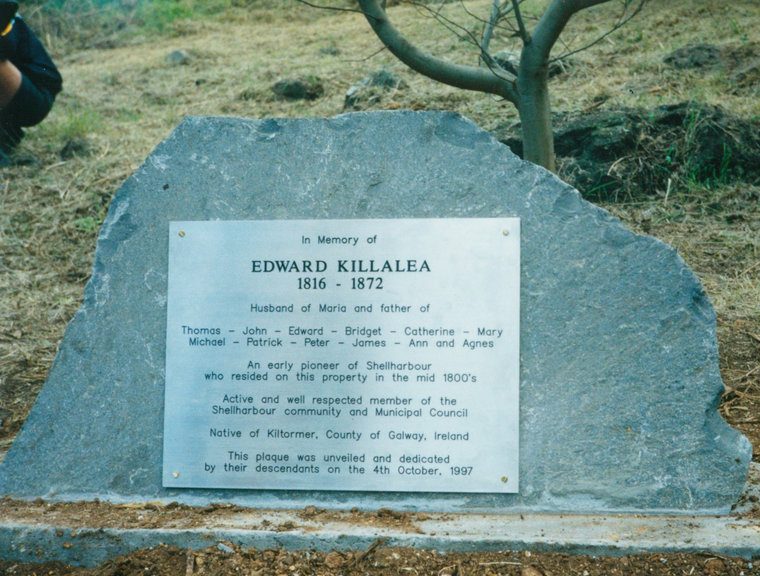
A memorial plaque dedicated to the memory of Edward Killalea by his descendants in 1997. Photo: Destination Shellharbour.








